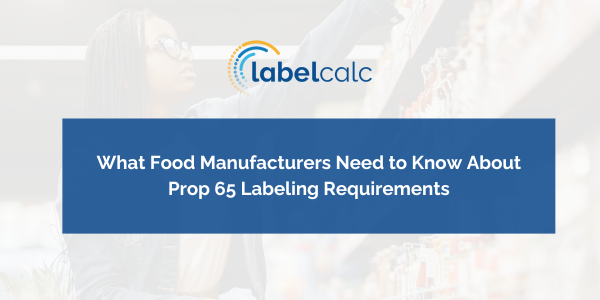If you’re a food manufacturer selling products in the United States, especially in California, chances are you’ve heard of Proposition 65 (also known as the Safe Drinking Water and Toxic Enforcement Act of 1986). While it’s not regulated by the FDA, Prop 65 has become a critical consideration for food businesses, particularly when it comes to product labeling and ingredient transparency.
Here’s what you need to know—and how to stay compliant.
What is Prop 65?
Proposition 65 is a California state law requiring businesses to provide warnings on products that expose consumers to certain chemicals known to cause cancer, birth defects, or reproductive harm. These chemicals are listed by the California Office of Environmental Health Hazard Assessment (OEHHA) and currently number over 900.
While the FDA does not enforce Prop 65, it’s important to understand how it intersects with food labeling requirements, especially if you plan to distribute in California.
What Chemicals Are Found in Food?
Prop 65’s relevance to food labeling lies in the fact that many common food ingredients or byproducts from processing can contain listed chemicals. Examples include:
- Acrylamide – Formed in baked or fried starchy foods like chips and crackers.
- Lead – Can appear in chocolate, spices, or due to environmental contamination.
- Cadmium – Found in certain root vegetables and cocoa products.
- Arsenic – Often present in rice-based foods.
- Mercury – Found in some fish and seafood.
Even naturally occurring levels of these substances can trigger Prop 65 warning requirements.
Do You Need a Prop 65 Warning on Your Food Product?
If your product contains a listed chemical above the state’s “safe harbor” limit, you are legally required to include a warning. These safe harbor levels are defined as either:
- NSRLs (No Significant Risk Levels) for carcinogens, or
- MADLs (Maximum Allowable Dose Levels) for reproductive toxicants.
If no safe harbor level has been established for a particular chemical, you must determine through testing and risk assessment whether your product requires a warning.
What Does a Prop 65 Warning Label Look Like?
For food products, a common Prop 65 warning label might read, “WARNING: Consuming this product can expose you to [Chemical Name], which is known to the State of California to cause cancer and birth defects or other reproductive harm. For more information, visit www.P65Warnings.ca.gov.”
This label should be both:
- Clearly visible on product packaging or at the point of sale.
- Present on e-commerce pages if the product is sold online to California residents.
Recent Updates to Prop 65 Labeling Requirements
As of January 1, 2025, significant changes to California’s Proposition 65 “clear and reasonable warnings” regulations became effective. These changes impact how companies label their products to comply with Prop 65’s warning requirements, including “short-form” warning requirements.
Key updates include:
- Chemical Identification Required: All warnings, including short-form warnings, are now required to identify at least one chemical per endpoint harm (e.g., cancer or reproductive toxicity).
- Short-Form Warnings for Food Products: Previously, short-form warnings were not permitted for food products. The new regulations now allow food products to include specifically tailored short-form warnings, provided they include the required chemical identification.
- Internet Warnings: There is now clarification of the internet warning requirements and a retail seller’s responsibility to post internet warnings.
- Compliance Transition Period: Businesses can continue to use the formerly permitted warning language for products manufactured and labeled prior to January 1, 2028. This three-year compliance transition period allows for an unlimited sell-through period for products manufactured and labeled with the existing short-form warnings before the expiration of the transition period.
Top Five Compliance Tips for Food Manufacturers
To avoid risk and ensure your food product is compliant with Prop 65, ensure you’re following these best practices:
- Test high-risk ingredients regularly, especially spices, cocoa, rice, and baked snacks.
- Audit your supply chain for potential sources of contamination.
- Label proactively if there’s uncertainty and your product will be sold in California.
- Consult legal or regulatory experts to perform risk assessments.
- Document everything, including test results, supplier disclosures, and labeling decisions.
Prop 65 may be a California-specific law, but its implications are national, especially for food manufacturers shipping products across state lines. By understanding how it works, keeping up with the OEHHA chemical list, and ensuring your labels meet both FDA and Prop 65 standards, you protect your brand, your customers, and your bottom line.
If you’d like to learn more about managing compliance and staying ahead of evolving food labeling regulations, reach out to our labeling experts today.

